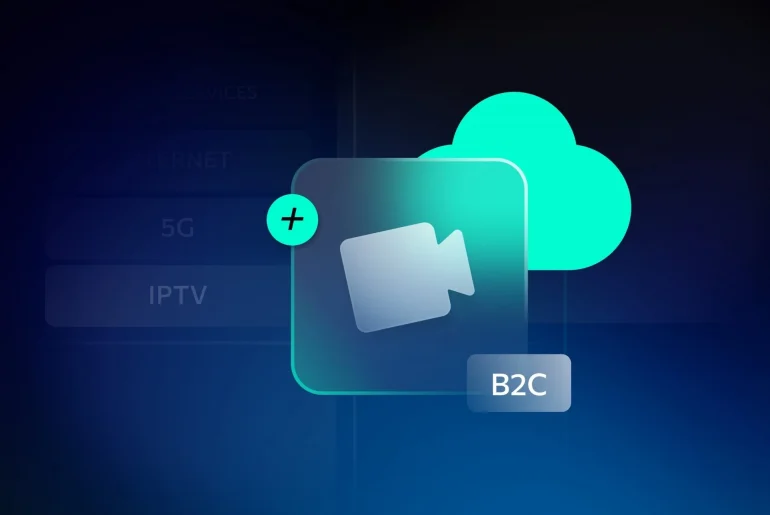How Telecoms Can Boost Revenue with Cloud Video Surveillance for B2C Clients
Expanding Telecom Business with B2C Video Surveillance
Telecom operators are uniquely positioned to deliver exceptional customer experiences using new technologies and emerging market opportunities. The telecom industry’s primary revenue streams typically come from the provision of core services such as fixed internet access and 4G/5G. However, this revenue alone may not be sufficient to sustain long-term growth and profitability. Learn how video surveillance service to B2C can empower telcos in current struggle.
Challenges Telecom operators face in modern sector landscape
Telecom operators navigate a complex and ever-evolving landscape facing a number of challenges:
- Price dumping in a competitive market. The telecommunications industry is fiercely competitive, with providers often resorting to price wars to attract customers. This can lead to shrinking profit margins and difficulty in generating sustainable revenue.
- Expanding the subscriber base. Acquiring new customers is crucial for growth, but it can be challenging in a saturated market. Operators need to find innovative ways to differentiate themselves and attract new subscribers.
- Subscriber churn. Losing existing customers (churn) is a constant threat. Operators must focus on customer satisfaction, loyalty programs, and value-added services to keep customers engaged and prevent them from switching providers.
- Avoiding becoming a “pipe” for others. With the rise of OTT (over-the-top) services, some telecom operators risk becoming merely a data pipeline for content providers. This commoditizes the role and reduces their ability to capture a share of the overall revenue stream.
These challenges collectively force telecom operators to adapt and innovate. By finding creative solutions to these issues,operators can secure their position in the market, attract and retain customers, and foster sustainable growth.
How to transform challenges into growth opportunities? What strategies should telecom operators choose?
- Launching new Value-Added Services (VAS) helps telecoms stand out, combat price wars, and retain subscribers. Innovative VAS offerings create differentiation and add value, reducing churn and boosting customer loyalty.
- Bundling core services like internet with attractive Value-Added Services creates more appealing packages, enhancing value and reducing churn. Offering bundled plans shifts focus from price competition, boosting customer retention by providing convenience and added benefits in one package.
- Using internal cloud infrastructure for managed services allows operators to host their own VAS, ensuring data control and revenue growth. This prevents operators from becoming a “pipe,” enabling them to deliver unique services while retaining a larger revenue share.
- Partnering with experienced providers ensures smooth implementation of new services by leveraging proven solutions, saving time, and reducing complexities. Reliable partners with expertise streamline integrations, optimize resources, and facilitate successful deployments for launching innovative telecom services efficiently.
Could video surveillance services become the new VAS for telecom companies to diversify offerings and boost competitiveness, especially in B2C?
The answer is yes, definitely yes.
By offering cloud video surveillance-based services as part of their diversified service portfolio, telecoms can differentiate themselves from the competition, enhance customer loyalty, and generate additional revenue streams. This strategic move can help them address the challenge posed by disruptive OTT providers and many others ensuring long-term growth and profitability in the evolving telecom landscape.
Let’s dive deeper and find out which approaches in service launching bring successes in case of individual customers (B2C).
Effective strategies of providing cloud based video surveillance to the business-to-consumer (B2C) market
This strategic business decision enables the company to take advantage of the significant potential for widespread adoption and mass-market selling of cloud-based video surveillance services among individual consumers. By offering these services, the company is empowering everyday people to enhance their personal security and expand their own surveillance and monitoring capabilities within their homes and communities. Cloud-based video surveillance technology is more accessible and user-friendly, driving higher adoption rates among everyday consumers. Compared to traditional hardware-based systems, cloud surveillance simplifies setup and usage, making it a preferred choice for many.
The two core ideas behind the video surveillance service offered by the telecom operator are to provide a turnkey solution and a subscription model. This means that the operator takes responsibility for all stages of the process, from the initial design and approval to the installation and ongoing maintenance of the cameras,and subscribers only pay a monthly subscription fee. The primary goal of the operator is to make the process of ordering and utilizing the service as seamless and user-friendly as possible for the end-users. This approach benefits customers by allowing them to pay only for the services they use, avoiding unnecessary costs.
Customers are spared from managing technical aspects of the system, making it a hassle-free and cost-effective solution.
Case 1. Video surveillance service to B2C pricing plans approach for private residential properties
The first case study delves into the provision of cloud video surveillance services tailored for private residential homes. The service packages typically encompass a specified number of security cameras, installation services, and data storage capabilities. This modular design allows the service to be readily adapted to accommodate the diverse requirements of different types of residential properties, enabling customers to enhance the functionality of the system as needed.

Telecom operators can implement a tiered pricing plan for cloud video surveillance services catering to private homes, encompassing one-time upfront fees and recurring monthly subscriptions.
The plan can include the following:
- One-time upfront fees:
- Installation charges per camera that covers the initial installation costs associated with maintaining cameras
- Reinstallation charges per camera. The fee applies when relocating or reinstalling an existing camera
- The monthly subscription fee per camera. It includes real-time video access with a 7-day video archive and the option to record footage to personal storage. The archive depth can be expanded through a separate monthly tariff based on the number of cameras used. This model allows customers to pay according to their needs, with flexibility to scale the service as required.
This customizable approach to residential video surveillance lets homeowners select packages that fit their security needs and budget. With options ranging from camera count to archiving features, the service adapts to each home’s unique requirements. The system’s scalability allows homeowners to expand functionality over time, providing a flexible and evolving security solution.
This adaptability ensures that private homes can continually upgrade their security features, providing comprehensive coverage without the need for constant system overhauls.
Case 2. Service approach and pricing plans for condominiums
The second case study centers on the provision of public video surveillance services for individuals residing in apartment buildings. This service focuses on external video surveillance around the perimeter of buildings, on lift platforms, playgrounds and car parks.

Any resident who has subscribed to the service can easily access and utilize the system, making it a valuable security solution for the entire apartment community. If it is necessary to maintain the privacy of the entrances, access can be differentiated in accordance with the residence. This comprehensive approach to surveillance ensures that the safety and security of the apartment complex is effectively addressed.
To succeed, Telco operators should focus on widespread subscriber coverage and high service penetration. A successful model has 6-8 paying customers per camera.
By offering a structured pricing plan for cloud video surveillance services tailored to multi-family buildings, telecom operators can implement fixed monthly subscription fees, with potential discounts for bundles with core services. This strategy enhances service appeal with predictable pricing, encouraging customers to explore additional services. It attracts new customers and fosters long-term loyalty by offering affordable, adaptable surveillance solutions for multi-family residents. By incorporating discounts for bundled core services, telecom operators can enhance customer value and expand their service offerings, fostering a more comprehensive, cost-effective security solution.
Therefore, subscription fee covers access to video feeds from all cameras within the dwelling, including real-time viewing and a 7-day video archive. This eliminates the need for per-camera charges, simplifying billing and cost management for customers.
Bundled discount
To drive cloud video surveillance adoption, operators can offer a 50% discount when bundled with core services. This strategy boosts customer satisfaction and enhances the overall value proposition.
By implementing this straightforward and cost-effective pricing plan, telecom operators can effectively attract and retain customers in the multi-unit dwelling segment, expanding their cloud video surveillance service reach.
Is there a truly telcom-centric solution for running cloud video surveillance service to B2C?
– Partnering with expertise and experience
Expanding telecom offerings with cloud video surveillance services can be a good strategy for the B2C market. When choosing a partner, it’s essential to consider factors like industry expertise, track record, scalability, and support. A partner with a deep understanding of cloud video surveillance services can help navigate challenges, ensure smooth implementation, and enable long-term success. Selecting a partner who can adapt to evolving market demands and provide ongoing technical support is key to making the service widely adopted and successful. The software solution should minimize capital and operational expenses for the telecom operator. It needs to efficiently scale computing and storage resources to accommodate rapid subscriber growth, and seamlessly integrate with the telecom’s BSS/OSS, CRM, inventory management systems and more
Aipix empowers telecom operators and service providers with the tools they need to thrive in an evolving environment. By offering cutting-edge Value-Added Services (VAS) solutions like cloud video surveillance, Aipix helps operators transform their customer engagement strategies and secure a leading position in the market.
Conclusion
The Aipix Telecom Platform is tailored to meet the specific needs of telecom operators. With features like multi-tenancy, hybrid cloud deployment, auto-provisioning, and seamless API integration, it offers a comprehensive software solution for launching and managing cloud video surveillance services efficiently. Aipix enables telecoms to scale while ensuring flexibility and seamless integration with existing infrastructure. This platform empowers operators to build an ecosystem of digital VAS.
Implementing the Aipix solution unlocks numerous benefits for telecom operators. They can expand their service portfolios with attractive cloud-based offerings leading to increased Average Revenue Per User (ARPU). Finally, Aipix equips telecom operators to navigate the evolving market landscape with confidence. It achievs sustainable growth and exceeding customer expectations.
Maximize your business potential with our innovative solutions – contact us to learn how.





